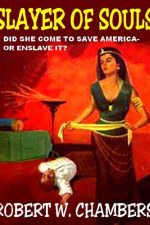 Robert William Chambers (1865–1933), author of over 70 novels in various genres, was born in Brooklyn, New York, to William P. Chambers, a famous lawyer, and Caroline (Boughton) Chambers, a direct descendant of Roger Williams, the founder of Providence, Rhode Island. Robert’s brother was Walter Boughton Chambers, the world famous architect.
Robert William Chambers (1865–1933), author of over 70 novels in various genres, was born in Brooklyn, New York, to William P. Chambers, a famous lawyer, and Caroline (Boughton) Chambers, a direct descendant of Roger Williams, the founder of Providence, Rhode Island. Robert’s brother was Walter Boughton Chambers, the world famous architect.
Robert was educated at a number of high-profile arts academies such as the Brooklyn Polytechnic Institute, the Art Students’ League (where the artist Charles Dana Gibson was his fellow student), the École des Beaux-Arts, and Académie Julian, and his work was displayed at the Salon as early as 1889. On his return to New York, he succeeded in selling his illustrations to Life, Truth, and Vogue magazines. Then, for reasons unclear, he devoted his time to writing, producing his first novel, In the Quarter.
His most famous, and perhaps most meritorious, effort is The King in Yellow, a collection of Art Nouveau short stories published in 1895. This included several famous Weird short stories which are connected by the theme of a fictitious drama, The King in Yellow, which drives those who read it insane. The play is set in the lost land of Carcosa, whose vistas are maddeningly unerasable from readers’ minds. E. F. Bleiler described The King in Yellow as one of the most important works of American supernatural fiction. It was also strongly admired by H.P. Lovecraft and his circle; it was primarily from Chambers’s rendering that Lovecraft evolved Carcosa as it appears in the Cthulhu Mythos.
Chambers returned to the weird genre in his later short story collections The Maker of Moons, The Mystery of Choice and The Tree of Heaven, but neither earned him such success as The King in Yellow. Some of Chambers’ work contains elements of science fiction, such as In Search of the Unknown and Police!!!, featuring the adventures of a philandering zoologist in search of unknown beasts. Chambers later turned to writing romantic fiction to earn a living. According to some estimates, Chambers had one of the most successful literary careers of his period, his later novels selling well and a handful achieving bestseller status. According to others, he hit the peak of his career with The King in Yellow and much of his later work consisted of popular, entertaining, less-than-monumental pulp stories for pay. During World War I he wrote war adventure novels and war stories. Some of these showed a strong return to his old weird style, such as “Marooned” in Barbarians (1917). After 1924 he devoted himself solely to writing historical fiction.
Robert W. Chambers died on December 16, 1933 after having undergone intestinal surgery three days earlier.
(Edited from Chambers’ Wikipedia and SF Encyclopedia entries. Follow the links for more information.)






